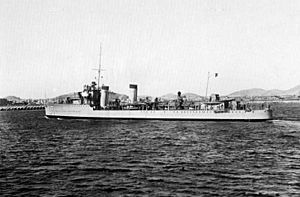Spanish destroyer Lepanto facts for kids
class="infobox " style="float: right; clear: right; width: 315px; border-spacing: 2px; text-align: left; font-size: 90%;"
| colspan="2" style="text-align: center; font-size: 90%; line-height: 1.5em;" | 
|}
Lepanto was a type of warship called a destroyer, part of the Spanish Republican Navy. She was named after the famous Battle of Lepanto from 1571. This ship played a big role in the Spanish Civil War, fighting for the government of the Second Spanish Republic.
Contents
| History | |
|---|---|
| Name | Lepanto |
| Namesake | Battle of Lepanto |
| Builder | SECN, Naval Dockyard, Cartagena, Spain |
| Launched | 7 November 1929 |
| Completed | 1930 |
| Commissioned | 1930 |
| Decommissioned | 24 May 1957 |
| Honours and awards |
|
| Fate | Scrapped in 1958 |
| General characteristics | |
| Class and type | Churruca-class destroyer |
| Displacement | 1,650 tons (normal); 2,067 tons (maximum) |
| Length | 101 m (331 ft 4 in) |
| Beam | 9.6 m (31 ft 6 in) |
| Draught | 3.3 m (10 ft 10 in) |
| Installed power | 4 Yarrow boilers, 42,000 hp (31,000 kW) |
| Propulsion | 2 Parsons turbines |
| Speed | 36 knots (67 km/h) |
| Range |
|
| Complement | 160 |
| Armament |
|
Lepanto in the Spanish Civil War
The Lepanto saw a lot of action during the Spanish Civil War. This conflict took place in Spain from 1936 to 1939.
Early Actions and Blockade
At the start of the war, Lepanto helped block the Gibraltar Strait. This was to stop rebel troops from moving from Spanish Morocco to southern Spain. On August 5, 1936, rebel aircraft damaged the ship. This happened just hours before a group of rebel ships, called the Convoy de la victoria, broke through the blockade.
Northern Front and Convoy Duty
In September 1936, Lepanto sailed to the Bay of Biscay. She supported Republican forces who were cut off on the northern front. For most of 1937, the destroyer was busy protecting convoys. Convoys are groups of ships traveling together for safety. During one of these missions, Lepanto took part in the Battle of Cape Cherchell.
Battle of Cape Palos
Lepanto played a key role in the Battle of Cape Palos in 1938. She was with two other destroyers, Sánchez Barcáiztegui and Almirante Antequera. They broke away from protecting the cruiser Libertad. Lepanto fired three torpedoes at the Nationalist heavy cruiser Baleares.
It is believed that Lepanto's torpedo caused the fatal hit that sank the enemy cruiser. Because of this important action, Lepanto and other loyalist ships received the Distintivo de Madrid award.
End of the War
On March 5, 1939, the crew of Lepanto and other Republican ships left Cartagena. They sailed to Bizerte, Tunisia, to avoid being captured. They arrived on March 11. The next day, the fleet commander, Miguel Buiza, asked for political asylum. The French authorities took control of the ships. Most of the crew were held in a camp. Later, new crews arrived on March 31, 1939, to take over the ships for the Nationalist side.
After the War
On April 2, 1939, just one day after the Civil War officially ended, Lepanto and her sister ships sailed back to Spain. They now had new Nationalist crews. They reached Cadiz on April 5.
Collision with Submarine C4
On July 27, 1940, Lepanto was taking part in an antisubmarine warfare exercise. She was with other destroyers, Alcalá Galiano and Churruca. They were practicing against submarines C2, C4, and General Mola.
About 24 kilometres (13 nmi) off Morro de la Vaca, Lepanto was moving at 14 knots (26 km/h). Suddenly, the submarine C4 surfaced just a few meters in front of her. Lepanto could not change direction in time. She hit the submarine on its side, between its conning tower and deck gun. The impact cut C4 in two. The C4, commanded by Capitan de Corbeta Francisco Reina Carvajal, sank in 300 metres (980 ft) of water. All 44 crew members were lost.
End of Service
Lepanto was taken out of service on May 24, 1957. She was then taken apart for scrap in 1958.
Images for kids
See also
 In Spanish: Lepanto (L) para niños
In Spanish: Lepanto (L) para niños


